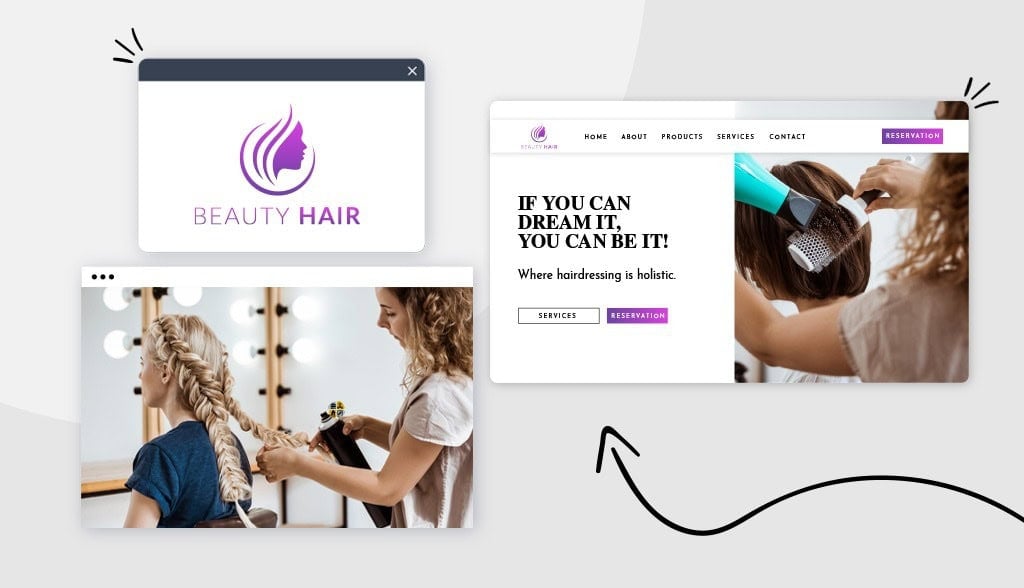
“Great hair doesn’t happen by chance; it happens by appointment.” -Author Jamie Foster.
And she’s right!
That’s why the hair salon industry’s worth $48.3bn, and the average hair salon owner’s income ranges between $75.000 to $175.000!
Those are impressive numbers, and why opening a hair salon could be the best business decision you’ll ever make!
But there’s a catch!
Opening a hair salon takes a lot of hard work.
For example, you’re responsible for choosing the right location, designing your salon’s branding, applying for licenses, getting insurance, attracting clients, and paying taxes.
Thankfully, it’s achievable when you know how to open a hair salon.
So, get comfy in your Sillón de peluquería, and I`ll tell you.
Your job’s bringing out the beauty in others, right?
And that’s only possible when you know everything there is to know about how to open a hair salon and where to invest your dollars.
Here’s a quick rundown of what that means:
Fortunately, statistics show that opening a hair salon’s a steady, profitable, and rewarding business idea. So, it’s worth the effort.
But first, you’ll need a business plan to ensure it lasts longer than a wash-out hair dye!
Creating a business plan is like learning to style a Side French Braid; it’s often easier than it looks! And you don’t need to be an experienced businessperson, or stylist, to do it.
Begs the question, though, why does your hair salon need one? Let’s find out:
These 4 reasons are why your new business needs a plan.
Convincing, right? You’ve got 2 types of business plans to choose from:
Although a one-page business plan is a personal blueprint to success and a traditional plan’s an extensive document with in-debt financial statistics and hypothetical
projections based on market research, both contain the following information:
If you need help writing your business plan, many websites provide templates or charge to do it for you.
Or you could check out my “how-to write a one-page business plan by asking the right questions” after reading this post.
Now a quick reminder of why opening a hair salon is worth the effort:
You can become a successful hair stylist without opening a salon; however, owning one has many pros.
Including:
All excellent reasons for learning how to open a hair salon, but you’ll require more than future possibilities; you need actionable steps, am I right?
Let’s get started:
Knowing how much your set-up costs will be is essential to staying on budget or applying for a loan.
A quick online search shows it can cost anywhere from $14.000 to $500.000 to open a hair salon. A little vague!
But don’t worry; here’s how you find the actual cost.
Where you are on the $14.000-$500.000 scale depends on whether you’re buying an existing hair salon, a franchise, renovating, or building a new one. And as it’s your highest cost, determine that one first.
Next, you’ll have expenses that fall into 3 categories: one-off, fixed, and variable. And that’s how you figure out your exact set-up costs.
Most of your set-up costs will be one-off expenditures, like:
One-off costs calculated (we’ll look closer at those in a moment) next determine your fixed monthly expenditure.
Fixed costs:
Fixed costs are expenses that remain the same regardless of your sales volume, are non-negotiable, and can include:
Variable costs:
Variable costs go up or down per your sales volume and are often negotiable, meaning you can cut costs and reduce expenditures.
Variable costs:
How to cut costs:
You can source cheaper alternatives to variable and one-off costs, such as 2nd hand or refurbished equipment and furniture. Negotiate better deals with suppliers and delivery firms as your sales volume grows. And avoid high employee costs by renting booths in your salon to freelance stylists.
I’ll explain next:
Several factors can influence the costs of opening a hair salon, such as location, premises (whether you rent or own), salon size, furniture/equipment requirements, employee costs, and insurance needs.
Planning for the best and preparing for the worst is how to run a successful business; insurance is part of that preparation.
Some insurances are mandatory, others depend on your business operations, and most salons need some or all of the following 4:
You can reduce insurance costs by applying for a Business Owner Policy that combines Commercial Property Insurance and General Liability Insurance.
Rent is often your highest expense when running a hair salon. But it’s unavoidable unless you own a commercial property in a great location or can afford a mortgage when interest rates are rising.
Consider this advice when renting:
Because if you sign a 5-year lease and your business fails in year 2, you could be liable for the next 3 years!
Your next highest expense is often equipment, and it’s easy to blow your budget if you don’t shop around.
For example, for $1,512.00, you could buy a Square Styling Chair from the Michele Phelafus collection. Or the almost identical Christina Styling Chair from buyritebeauty for $329.00!
What you spend, of course, depends on your budget, location, and target market. It’s advisable to make a checklist of essential equipment and only spend based on your business plan’s financial analysis.
Regardless of budget, your salon needs the following equipment:
It’s a good idea to buy what you can afford now and upgrade as your business grows. But if your budget doesn’t stretch that far, you’ve options for getting the best for less:
If you want new equipment, many sellers offer leasing (not a bad idea when first starting) and credit options. Just remember to add the costs to your fixed outgoings.
Speaking of which!
Rent and equipment expenditures can distract us from the smaller ongoing costs you’ll still need to pay.
Ongoing, also known as operating costs, combines your fixed and variable monthly expenses; here’s a quick recap:
Your outgoing monthly costs are continuous and add up. So, ensure you account for every dollar in your business plan`s financial projections to allow for an adequate cash flow.
Miscellaneous expenses are usually those you should have considered but have yet to.
Ways to prepare for them are spending money wisely, keeping your running costs low, and prioritizing needs over wants, especially if using credit to open your hair salon.
Begin with the basics, make some cash, and speak with your customers to discover their needs. After all, a tanning spray booth could be a better investment than a posh sofa!
And keep 3 months’ rent in the bank and enough to cover one month’s utility bills and supplies, so you’re ready for unforeseen expenses.
Quick question, have you heard the term “Goldilock zone”? Of course, you have, and your hair salon needs one to succeed!
But in case you haven`t, allow me to explain:

Location is one of the most critical factors when opening a hair salon.
For example, you could spend $250.000 on a salon refit, fill it with expensive equipment, and employ the best stylists, but if you choose the wrong location, your seats could stay empty!
But what are the best salon locations, and how do you choose the right one for your business?
Stick with me because it`s easier than you think:
Sure, the price can reduce your options, but you don’t need a high-street or mall-based salon to succeed. And avoid city centers because they have a high price tag, and people hate driving in congested areas with lousy parking.
A better option is to ask yourself this question:
Does the area suit the image of my salon?
Where you open your hair salon says everything about its style and the customers you serve. So, when choosing your location, ensure the area’s image fits both.
Footfall, also called store traffic, counts the number of people entering a store/shopping mall or passing a specific location per hour, day, week, month, or year.
High footfall traffic passing your hair salon is crucial because the more people that walk by, the more chances they’ll step in. It’s also free advertising, saving costs on expensive marketing campaigns to create public awareness.
However, high footfall traffic doesn’t always mean strong sales; for that, it must be the right footfall, IE, those that want your service.
The following 3 location must-haves explain why:
In America, 76% of people use cars to commute to work, shop, or drop the kids off at school, which means parking. And not having it could kill your salon’s chances of success.
Your parking must be convenient, and ensure there’s enough for every styling chair and stylist you have in your salon when fully booked.
But what if parking isn’t viable? Here, your clients will need public transport:
Similar to parking spaces, access to public transport simplifies the process of clients and staff reaching you. Encouraging people to book an appointment even when they live in another town.
So, what’s the solution?
The Goldilocks zone refers to a planet’s distance from a star (our sun) being just right to sustain water. The location’s neither too hot nor cold but just right; it comes from Goldilocks and the 3 bears.
Your salon needs to be in a similar location to sustain a business; here’s how:
Once your location has those, you`ll be in a Goldilocks zone.
Okay, next, all things legal.
Now, this is important, and what I`m about to tell you could save you money and trouble down the line:
Registering your business is how you make it official. And depending on your chosen structure and location, it can be a prerequisite to opening a business bank account, raising capital, and paying taxes.
Registering your business is something to get excited about, as it’s a significant step toward turning your dreams into reality.
Here are the 3 most popular business structures for hair salons:
A business structure is a legal entity formed by filing an Articles of Organization with your Secretary of State’s office.
Legal entities come in several forms, such as Limited Liability Companies (LLCs), Limited Liability Partnerships (LLPs), and S or C corporations.
Your choice determines how you’ll set up and run your business, pay taxes, and your level of personal liability. So it’s an important decision and one you should consider carefully.
You can open your hair salon without registering a legal structure. But while that’ll save you the filing fee, risks are involved; I’ll explain why next.
Here are your main options:
Choosing where you register your business is crucial before you open a hair salon because it affects your legal requirements and tax liability.
Most folks register their business in their home state because of the convenience of local government offices, lawyers, and accountants who understand state rules.
However, you can register your business in another state with more favorable registration fees and taxes, such as Delaware and Wyoming, which don’t charge income tax!
When registering a legal entity, you must apply for an Employer Identification Number (EIN), given to businesses by the IRS, to file taxes.
You can apply for an EIN online via the IRS website or by mail and fax. Or use our EIN application service, which simplifies the process.
Once you receive your EIN, your next step is choosing your tax year; you’ve 2 choices:
A calendar or fiscal year determines when you’ll pay tax. Your business structure, your tax requirements. And your chosen state how much you’ll pay.
The IRS website provides a taxpayers checklist to help you make the right decision for your business.
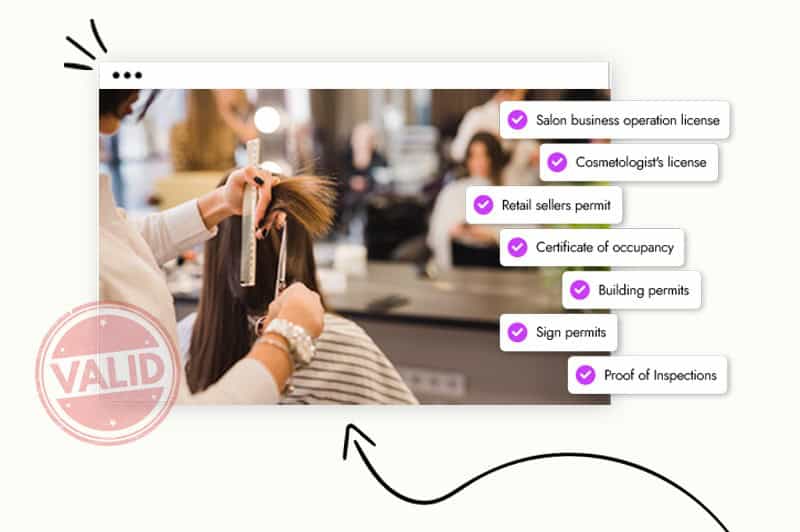
To avoid local, state, or federal fines, getting the correct licenses and permits is essential when opening a hair salon. Or lawsuits by unhappy clients and the closure of your salon before you’ve begun.
Each county, city, and town has unique licensing requirements. So you’ll need to contact your town hall and the state’s chamber of commerce to clarify your legal requirements.
You may also require state-level and federal licenses and permits. You find out by visiting your state’s or the Small Business Association’s website.
Let’s look at the most common permits and licenses at the local, state, and federal levels.
Local health and safety laws and regulations require you to get permits to provide a specific service or product within your location.
Rules and regulations vary by your services, such as hairdressing, facials, waxing, manicures, massages, false nails, lashes, etc. You’ll also need local permits for waste management and alteration works on your proposed salon.
Permits ensure your salon’s safe for public use; this is the law, and most insurance companies won’t insure you without them.
You’ll also need state licenses and permits, the main ones being a business license, a DBA if trading under a name other than your registered one, and health licenses from the Occupational Safety and Health Administration (OSHA).
You might also require federal licenses and permits. However, those are usually for specific industries that deal with alcohol, firearms, aviation, agriculture, etc.
That said, you should file a trademark to protect your intellectual property, such as your business name or logo, at the federal level.
Aside from local, state, and federal licenses, here are the main licenses and permits you’ll need when opening a hair salon:
All US states require you to have a business operation license (also called a business license), which allows you to operate in your state.
You can apply for a business license by contacting your secretary of state’s office and learn all about it on the U.S. Small Business Administration website.
Most states require anyone in the beauty industry to have a cosmetologist license.
You can open a salon without one if you don`t work in it. But any stylist or beauty therapist you employ or allow to rent a booth in your salon needs a cosmetologist’s license.
Requirements for getting one vary by state, however:
Anyone selling products to consumers must pay sales tax to their state. The amount you charge depends on your state rules, but 8% is an average.
You’ll need to register for a Tax Identification Number/resellers permit with your state’s tax office to pay sales tax. To get a tax ID number, you must provide your personal details, business operation license and describe the products you plan to sell.
The Certificate of Occupancy is a legal document that certifies your property complies with local and state requirements and is fit for business. And as salons require specific water installation, waste management, and chemical treatment, you’ll need one.
Contact your town hall or building department and ask what steps you must take to get a certificate of occupancy before you start any building works.
Speaking of which:
Whether installing new plumbing, knocking down a wall, or doing a complete renovation, you’ll need a building permit.
Building permits ensure all work complies with local and state health and safety standards and is allowable with your property type.
You must apply for a permit before any work takes place. Contact your town hall to learn about any specific requirements for building permits in your area.
Your salon needs a sign, and you’ll need a permit. Be aware that local governments have strict rules concerning signage type, size, and position.
So contact your town hall to find out more.
Before you open your hair salon, an official inspector must review your property to confirm it adheres to all local/state health and safety guidelines.
To ensure your salon passes the proof of inspections, contact your local inspection service/town hall for a copy of their health and safety requirements and guidelines.
And create a checklist to identify any areas that need improvement to ensure you pass the first time.
Okay, that`s the legalities; now things get interesting!
Your ideal customers are those people who`ll connect with your salon’s brand personality and feel fulfilled by your service.
Now, your salon isn’t a one size fits all service, but you must identify your ideal customers to create an ambiance and marketing strategy that attracts a loyal, diverse clientele.
And the clearer your ideal customer description is, the more effective your marketing strategies will be.
What your ideal customers will feel about your salon:
Customers will return when they feel one of those things about your salon. Make them feel all 5, and they’ll be with you for life.
How to identify your ideal customers:
Imagine running a successful marketing campaign, opening your hair salon’s doors, and welcoming your first customers. The place is buzzing, clients are waiting, and your stylists are ready to go.
Feels great, right?
Now visualize your client’s demographics and style and observe how they converse and interact.
You’ll design your salon and marketing campaigns around the people you see are your ideal customers. However, you don’t have to limit your salon’s reach. You can choose a specific style and still attract a broad audience, and it often pays to do so.
Broad appeal
Having a broad clientele increases your salon’s square footage revenue opportunities, and that’s good business.
You attract a wider audience by doing 2 things.
To implement number 2, you must first determine your core services:

You learned core hair salon services in cosmetology school, like cutting, styling, blow-drying, and coloring.
But there are many add-on services your hair salon can offer that’ll increase your client base and income.
First, let’s ensure you’re maximizing those all-important core services:
These include:
Those basic services alone could keep your salon busy. However, by offering add-ons, you could take it and your revenue to another level.
Add-ons can be something other than hair related, and the more versatile you are, the better.
We’re talking about services that increase your client’s satisfaction and revenue that you can implement when designing your salon. And you don’t have to be multi-skilled; you could partner up with other professionals who offer the following services:
Well done, you’re halfway through the post.
Now, stick with me because the next part is finding your clients, engaging their interests, and getting them through your salon’s front door.
And that starts with your brand:
Brilliant branding establishes relationships with your target audience, turning them into loyal customers, so it’s worth every dollar.
Begin by thinking about what makes you and your salon unique. Is it your core or add-on customized services? Professional experience? Or attentive stylists and staff?
Next, consider what style suits your ideal clients’ demographics.
When you have both, make them the core of your identity and develop your brand around them.
And use your branding to ensure your salon stands out by being noticeable and exciting.
Developing a brand isn’t something that happens overnight. That said, here are 5 elements you must get right from the beginning:
Shakespeare was pretty good but was wrong when he wrote: “what’s in a name” (meaning names are irrelevant).
Your business name’s far from irrelevant; it’s your brand identity and must encapsulate your services, objectives, salon personality, and mission in a couple of words!
Here’s how to choose one:
You can use online business name generators like Naminum, Panabee, and Wordlab to help you come up with the perfect brand name. Or ask family and friends, and check out your competitors for inspiration.
Here are some memorable hair salon name examples:
Notice how they’re all short, catchy, and easy to say? Making them memorable, promoting word-of-mouth marketing and online search results.
Once you’ve chosen some names, visit the US Patent and Trademark Office website to ensure they’re available.
Next, you’ll need a logo:
Logos may be small, but their importance is unmeasurable.
Think of 3 right now. I bet it was easy, right? And when you visualized them, did you get different feelings?
That’s what makes logo’s so important and why getting your logo design right is crucial.
There’s a lot to learn about logo design. However, here are 5 steps all top logo designers use:
Stuck for ideas? Don’t worry, because online tools are available to help you create the perfect hair salon logo design.
Here are some examples of clean, effective hair salon logo designs:

The white space is the bits around the icons and wording! When you have your logo, it`s time to create your salon’s website:
Your website is often your leading online presence and where you’ll convince future clients of your professionalism and expertise. And how you’ll enable people to review your services and make appointments.
You don’t need to be tech-savvy to build a website. You can hire web developers to create a cool-looking custom website on freelance platforms like UpStack, Upwork, Fiverr, Flexiple, and PeoplePerHour.
Or you can create a hair salon website using services like Wix, WordPress, Squarespace, or Webflow.
Hair salon website tips:
Check out these examples of engaging hair salon websites made using Squarespace, Wix, Webflow, and WordPress website-building platforms:
Lunatic Fringe
Lunatic Fringe promotes its style and engages its target audience with this classy-looking homepage. Made with Squarespace.
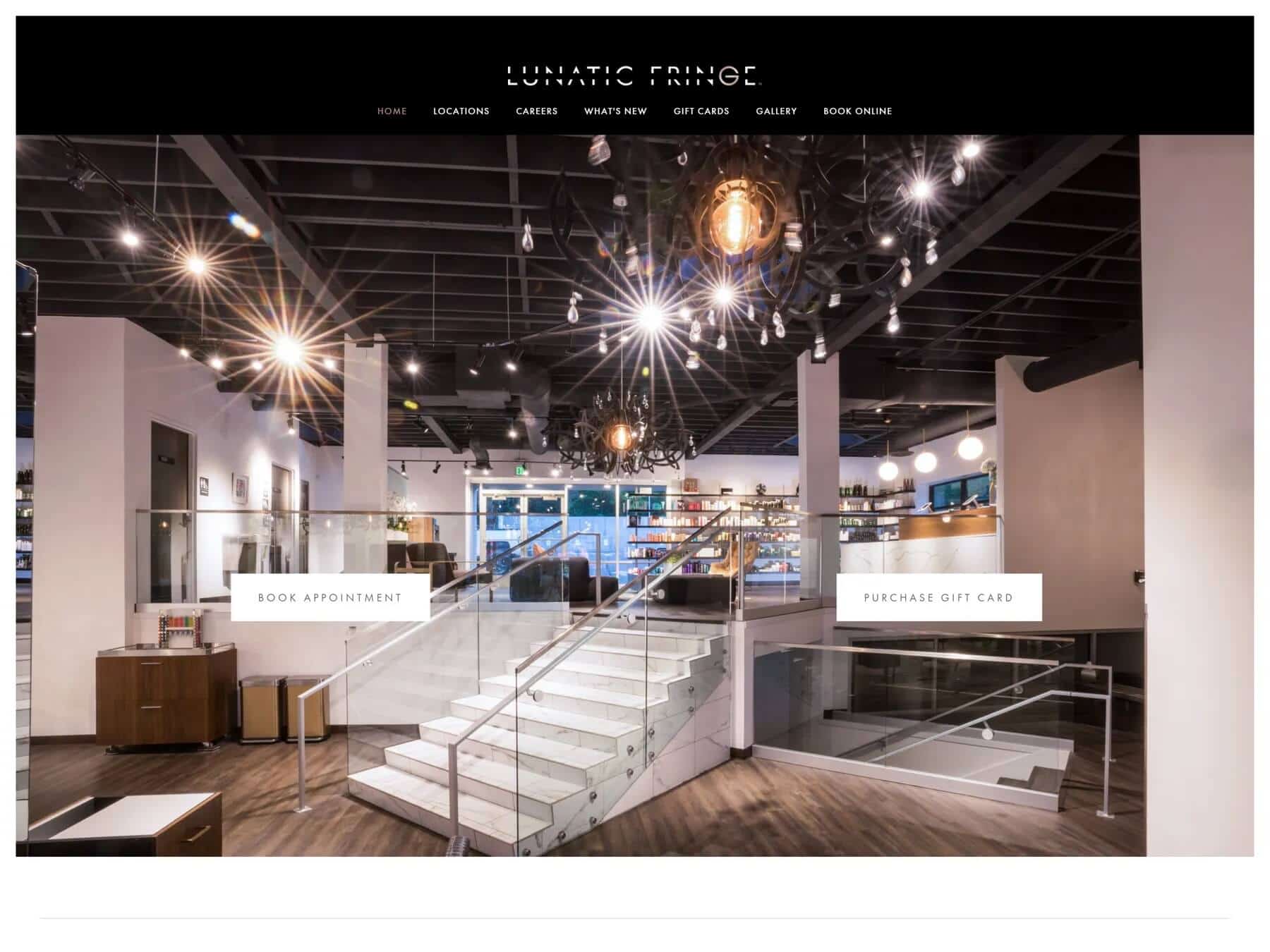
Parlor by Haides
One for the guys. A clean-cut and easy-to-navigate site. Made with Webflow.
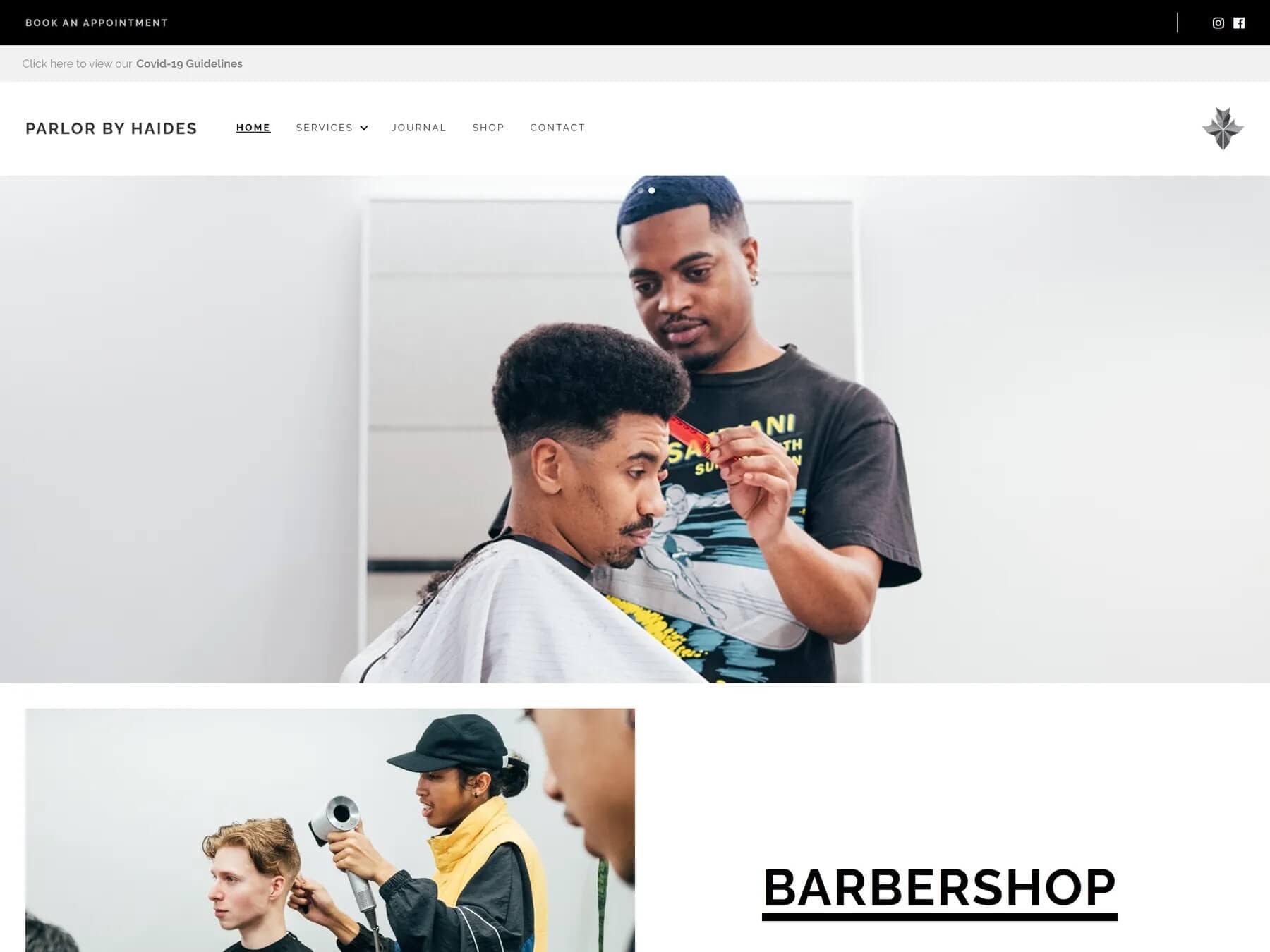
Solo Salon
Solo Salon created a simple and informative website that conveys everything about its services. Made with Wix.
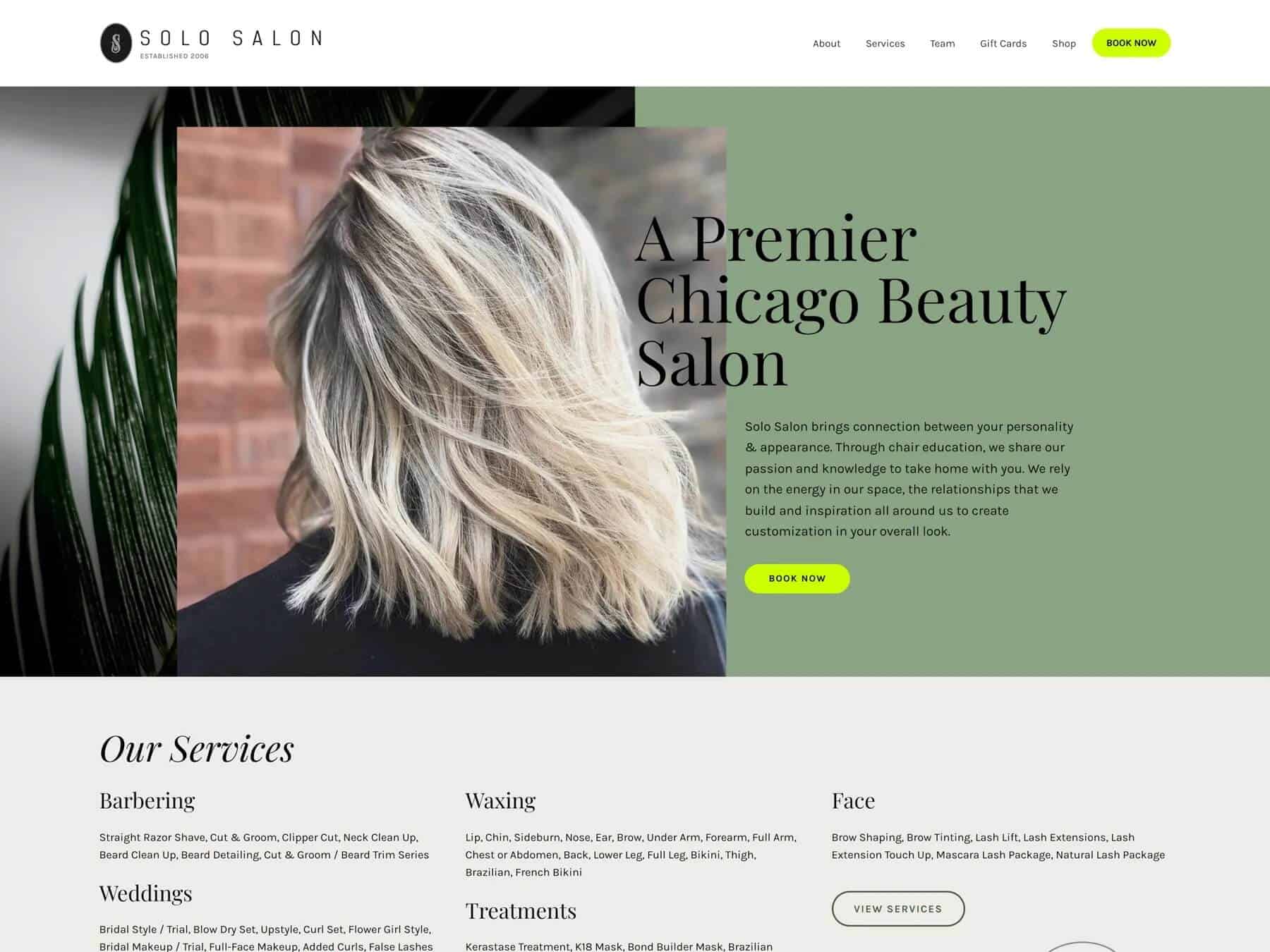
Notice how all 3 websites have their unique look?
The owners/web designers infused them with the brand’s style using visuals that match their brand’s personality and target audience. It`s a clever technique; let’s look at how to do it:
So, what’s your style?
Your answer defines your brand’s visuals; you’ll use those to create your salon interior, website, and marketing materials.
Brand visuals, also known as your visual identity, convey your brand’s message, engaging your prospective client’s interest. Leaving them wanting to learn more about you and your salon.
Brand visuals include:
All 3 websites above use these elements to communicate their style and services. But they all have one thing in common: their brand visuals are unique and stand out from the crowd.
No one can tell which design to choose for your salon because only you know your style and target audience.
However, some design strategies ensure your salon’s interior harmoniously flows, fulfilling your stylist’s and client’s needs while infusing the interior to reflect your brand.
The first is functionality.
Elements every hair salon needs:
The best salons work for the owners, not against them, and are practical while remaining attractive and comfortable. You achieve that by maintaining a harmonious balance and coordination between all the areas in your salon.
A hair salon has 3 key areas:
Next, you need to develop the look and feel of your salon.
Here’s a great technique that can help you visualize it: Envision how you want your customers to feel, their experience, and which adjectives they’ll use to describe your salon.
At this stage, it helps to choose a theme. Once you have that, you can design.
The design process:
You have 2 choices when designing your hair salon:
Self-design is cheaper, and plenty of free examples are available to emulate.
For instance, you could visit other salons and combine the best designs to create your unique salon. Or go online for design tips from websites like Impeccabuild, technical designs from Biblus, and inspiration from Pinterest.
Option 2 uses a professional designer’s knowledge, and that’s invaluable.
Find designers online via websites like Truelancer. And advertise your project on freelance design platforms like Toptal, Upwork, PeoplePerHour, LinkedIn Profinder, and SimplyHired to get the best deal.
Let’s say you choose option one:
Your next step is to create your hair salon design plan per your needs, style, and target audience. Now is also when you infuse it with your brand visuals, such as your logo and brand colors.
Once your physical layout and brand visuals are in place, you’ll need a quality contractor with plenty of testimonials and source materials.
Okay, now it’s time to talk about what you’re worth:
Finding the right price is often difficult when starting a business. Overcharge, and you’ll lose clients; undercharge, and you could lose your business!
Fortunately, deciding how much you will charge isn’t a guessing game. You can find the correct prices for your salon’s services by researching your local area and calculating your fixed and variable salon costs.
Costs fall into 2 categories, fixed and variable. We looked at those earlier, but now you must get an exact number to determine startup and running costs.
Startup costs are one-off and not included in your monthly outgoings unless you repay a loan/mortgage.
Running costs determine what you’ll need to charge per client per service and the number of clients you’ll need to cover your expenses and make a profit.
And don’t forget to add your wage and that of any employees.
Location plays a massive part in what services you can offer and what you can charge, as it determines your target market.
For example, a salon in Manhattan can charge more than a salon in Yazoo City, Mississippi, but the rent will be cheaper!
While researching your location, check out your competitors for the average salon rates and services in your area. You don’t have to charge the same (I’ll tell you why next), but a ballpark figure helps you find your price tiers.
Average salon prices are often for average salons, and you’ll find that your location has hair salons at both ends of the pricing scale.
Price your services based on your training and experience, and don’t underestimate yourself or your skilled stylist. Because if you’re better than your competitors, charge more.
Charging more for popular time slots is standard in the salon industry and how you’ll balance your monthly income.
For example, midweeks appointments might be slow, so you could promote a lower price to attract clients. In contrast, late-morning weekend slots are always in enormous demand, so price accordingly!
People pay for convenience, and you’ll increase profits by charging more for popular appointment times.
The products and services you offer also impact your pricing. Some may be in more demand than others, especially in different seasons.
For instance, tanning services peak in the springtime, and bridal party hair styling in the summer. So diverse your services to take full advantage of your local market and charge per demand.
Okay, now take a break and stretch a little because next, we’ll look at your free and paid marketing options and how to get the most for your dollar.
Marketing is essential for every business, but specific marketing channels are more relevant for a small local hair salon business.
Excellent news because you can invest your marketing dollars where you’ll get the highest return on investment (ROI).
Traditional marketing is invaluable for your salon’s advertising dollars because you’re a brick-and-mortar business. And when done right, it will help you become part of your community and build a loyal following of clients.
Online marketing is also essential to ensure everyone can see and find your salon, especially your target audience living in other nearby locations.
When you combine the 2, you’ll be in business. Here are some tips on how to do it:
Digital business cards are a safe and modern way to store and share your contact information online in a virtual file.
You can include your name, photo, phone number, email address, website, location, social media links, user bio, and other critical business info.
And use your digital business card to extend your brand by uploading your logo and other visuals. Enforcing your salon’s connection with your customers.
You share your digital business card with prospective clients and other businesses by sending a QR code via your social media or email accounts. The recipient scans the code using a smartphone, and Voila!
Creating your digital business card:
The following marketing tip is easy to use and a must-have for every brick-and-mortar business:
Google’s free business listing works brilliantly for local businesses by listing them online with Google maps.
For example, use Google to search for “hair salons near me.” The map with local salons appears along with the top listings, including the business name, address, website link, images, and other relevant information.
Here’s an example of salons near me in Yonkers, NY:
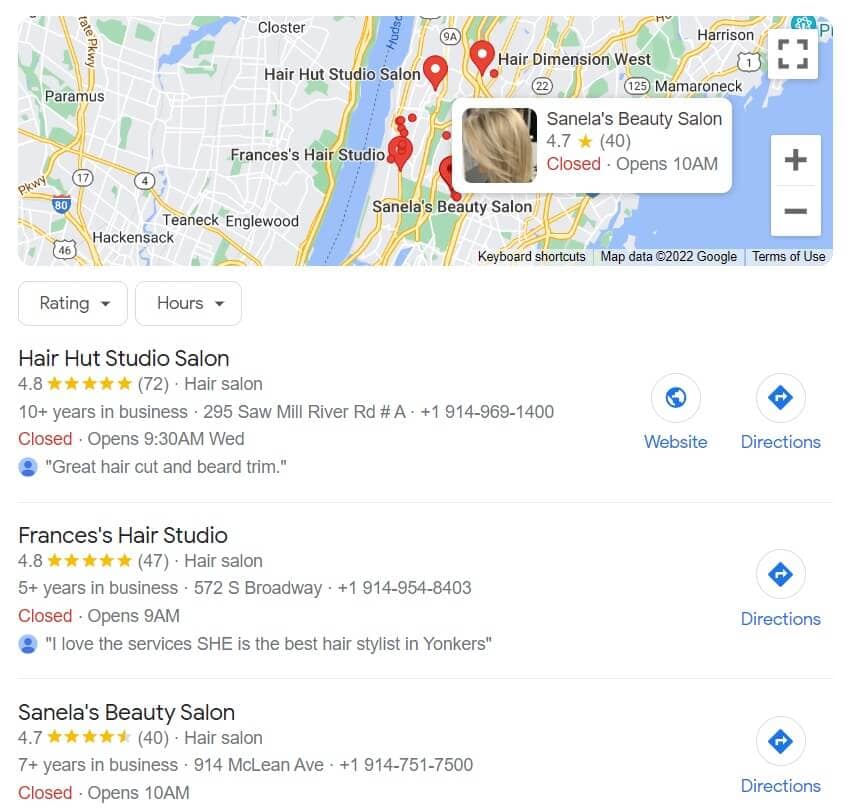
Cool, right?
How you claim your business listing through Google Maps
Once you gain access to your Google Business Profile, add the following information to help your business rank higher on Google’s listings.
Add any additional business categories:
Select “hair salon” as your primary business category, and add any additional categories/services your salon offers.
Update your opening hours:
It seems obvious. But many businesses neglect this, which can lead to negative reviews, and you don’t want those. Also, include any special opening hours, like public holidays.
Add your business description:
Google allows you to use 750 characters to describe your business. Here’s where you’ll write an engaging description of who you are and your services.
And mention any add-on services, awards you’ve won, and your stylist’s level of training. Also include words and phrases customers will use when looking for a hair salon to improve your listing’s SEO.
Add fabulous photos of your creations:
Google provides a photo gallery where you can add before and after photos of past clients. Images are a powerful marketing strategy for hair salons, so fill your gallery with happy customers and your salon’s brand-infused interior design.
Include your website/appointment links
Finally, use Google to connect to your website booking page by adding your website’s URL.
Now it’s time to get local:
A local directory lists the same crucial business information as Google. Such as your business name, location, opening hours, contact info, pictures, etc.
The fundamental difference is these are local, and that’s important!
Why you should be in local directories:
Local listings enable local businesses to connect with their target audience, which is essential for hair salons.
You can also use your local directory to generate reviews, improve your website’s SEO, and direct potential customers to your website, increasing brand awareness.
How to find the best local directory:
Many local directories are available, such as local listings, business listings, niche, and general directories.
You can find the best local directory for your business using a research platform like Semrush. The Semrush listings management tool (I’m not an affiliate) shows you where your business isn’t listed and, for a fee, registers your business on the most relevant business directories.
Online listings are brilliant for driving business to your salon, but nothing beats WOMM.
I’ll explain why next:
WOMM passes information about a service or product from one person to another.
And in the personal relationship-driven industry like hair salons, word-of-mouth marketing is your best marketing.
Check out these stats:
How to use WOMM for your hair salon:
Word-of-mouth marketing relies on your customers having a fabulous experience, encouraging them to share it with work colleagues, friends, and family.
But it doesn’t happen miraculously; you must encourage it using specific techniques:
Speaking of which:
Of course, your hair salon must be on social media, but the question is, which platforms?
The simple rule about choosing social media platforms for your business is to be where your audience is.
Facebook and Instagram have over 4 billion users, so they’re a safe bet. But Twitter, LinkedIn and Yelp could prove invaluable to your salon, depending on your target market.
That said, Instagram and Facebook are both great platforms to start with. Here’s why:
Instagram:
Instagram caters to the female audience, is super easy to use, and is perfect for connecting with your followers.
Images and stories make Instagram essential to hair salon owners, especially if your target audience is a younger demographic, as 71% of Instagram users are under 35.
Facebook:
Facebook is untouchable for running ad campaigns, promotions, and building communities. And those mean more clicks to your website, appointments, and revenue.
Facebook suits salons that target a broader demographic, with 18 to 54-year-olds making up 82.2% of its ad audience.
Whichever platform you choose, you must post interesting and relevant content (words or images) regularly and consistently to stay high in the rankings and retain your target audience’s interest.
All the above are proven marketing strategies, and most lead back to one place, your website:
Building a website is one thing; knowing how to set it up so prospective clients will find you, like it, and make an appointment, is another!
So, let’s finish with some proven design techniques to help make that happen.
How to set up your website:
Here’s an example of all of that at work.
PARLOR BY HAIDES which I mentioned earlier is an excellent example of how to build a professional salon website. Notice how clean it is, how they enable clients to book and contact them, and its use of images.
Page 1 - Homepage
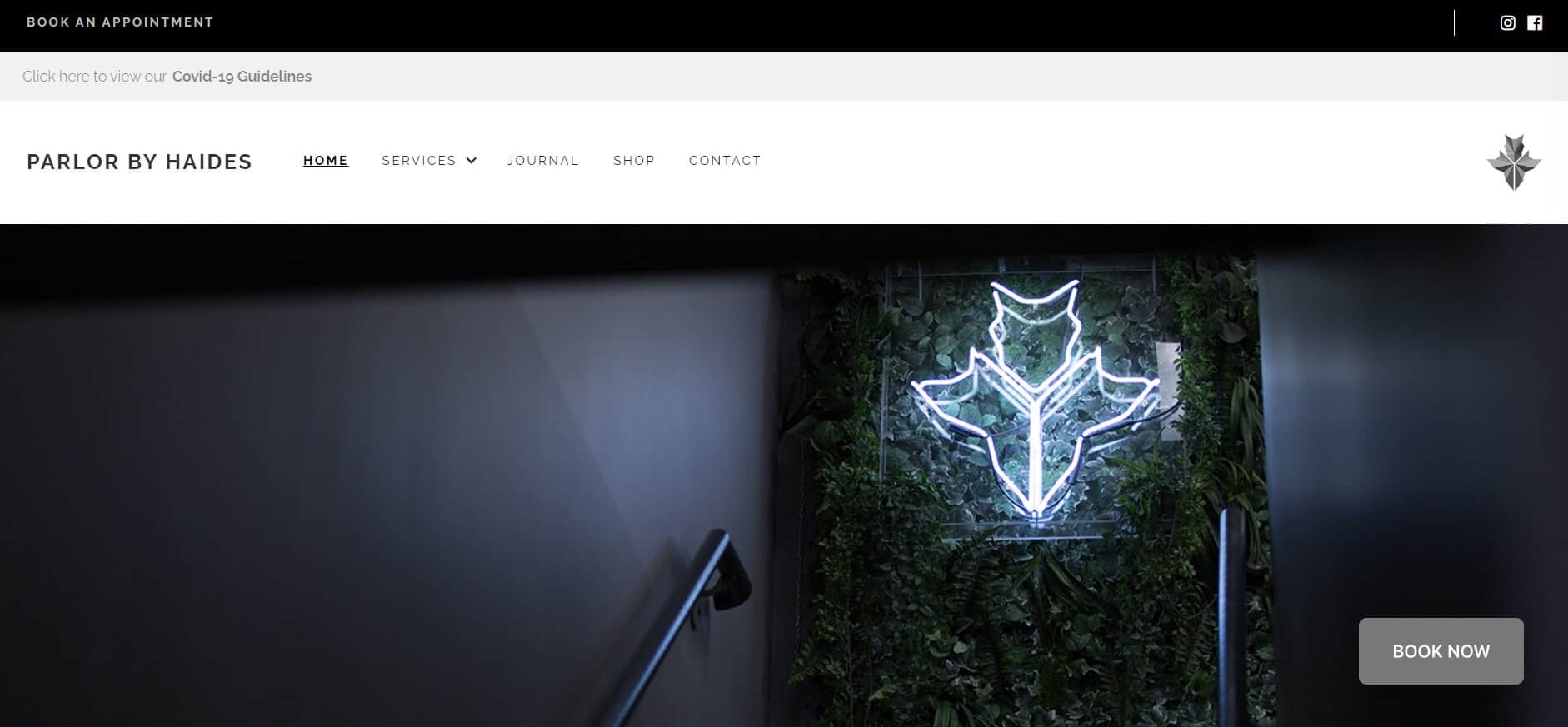
It tells you their style and is easy to navigate. Their menu bar contains everything you need to know, such as services, journal, shop, and contact. And there’s a convenient call to action (CTA) book now button.
They also use a slider to show the salon is for girls and guys:
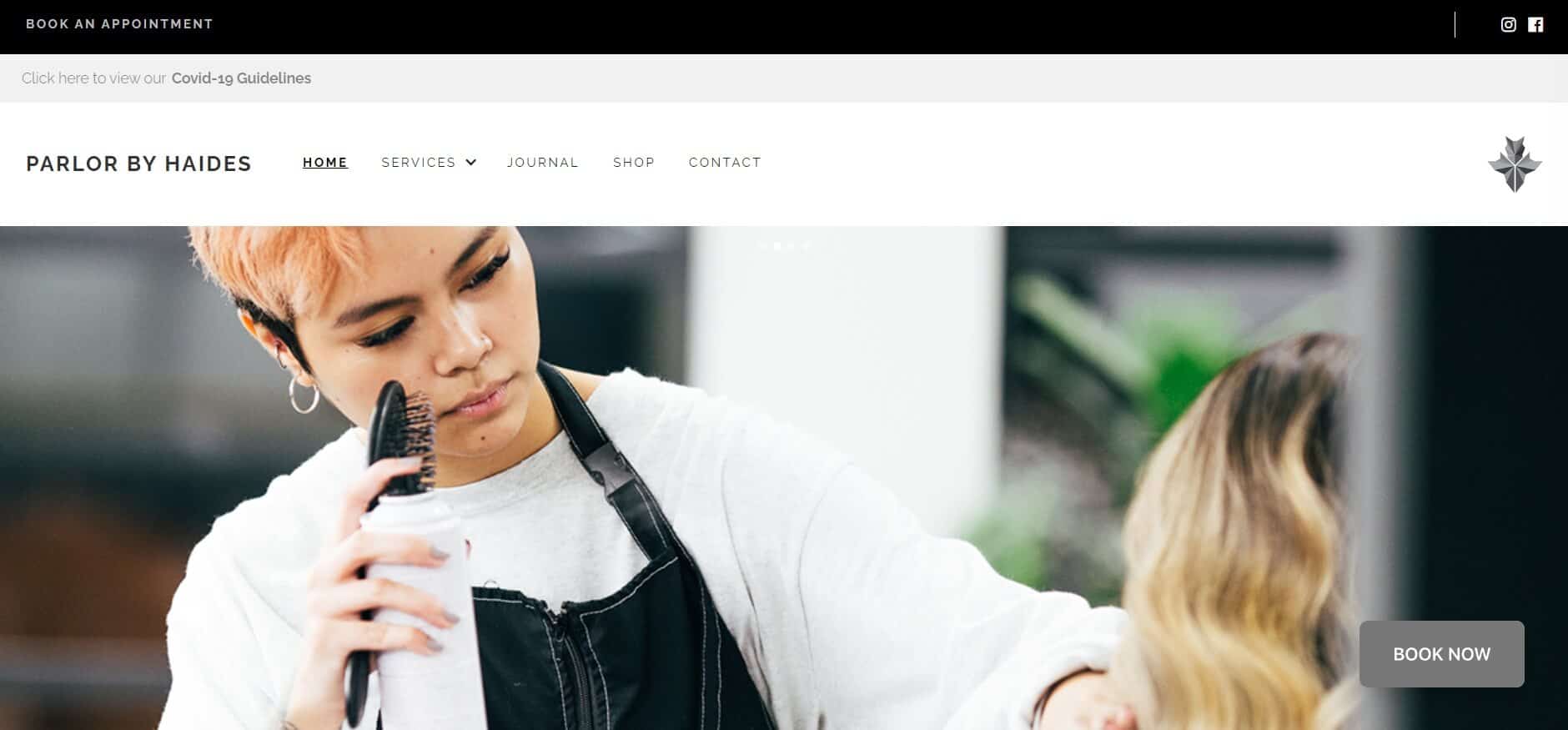
Page 2 - Service
They give you 2 options, barber and salon:
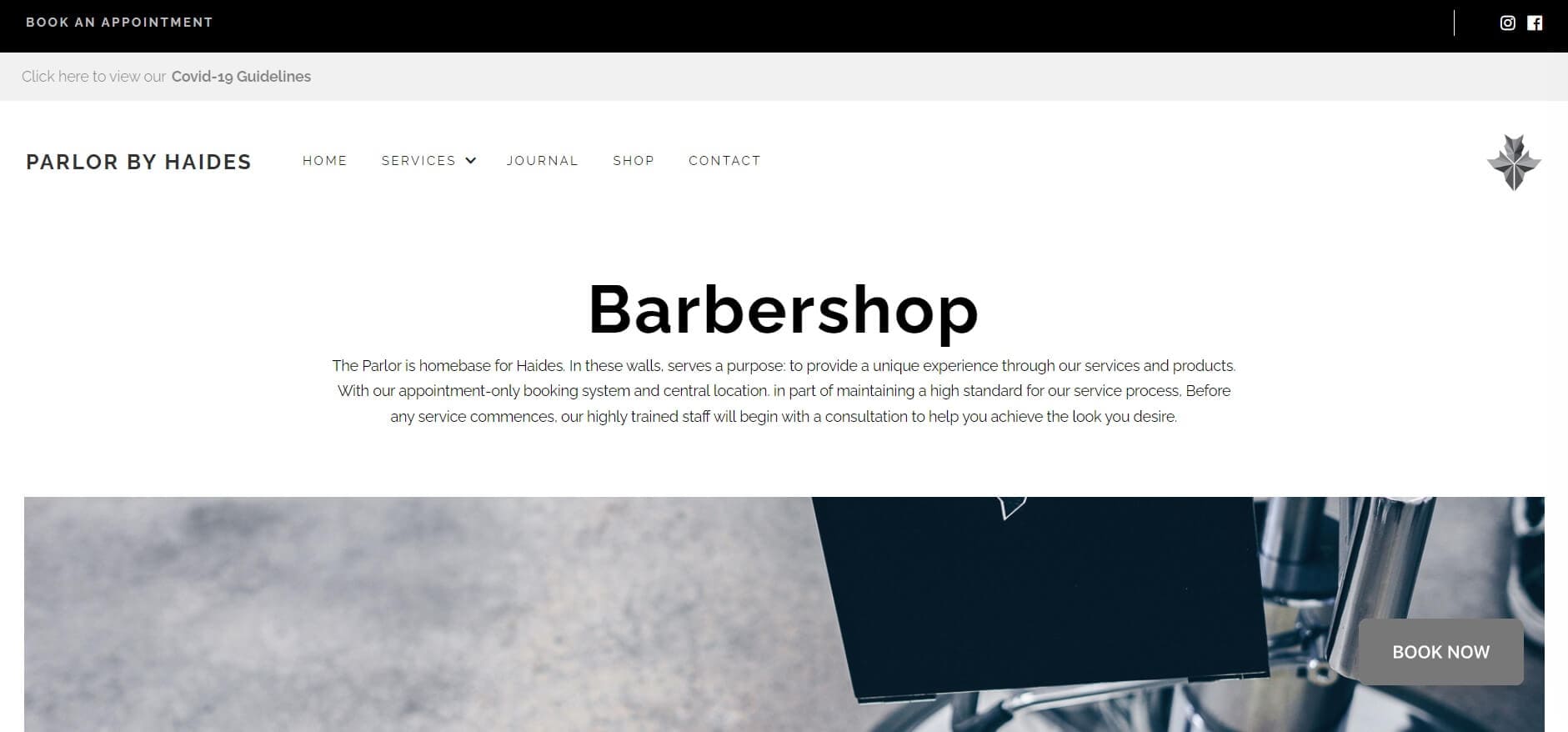
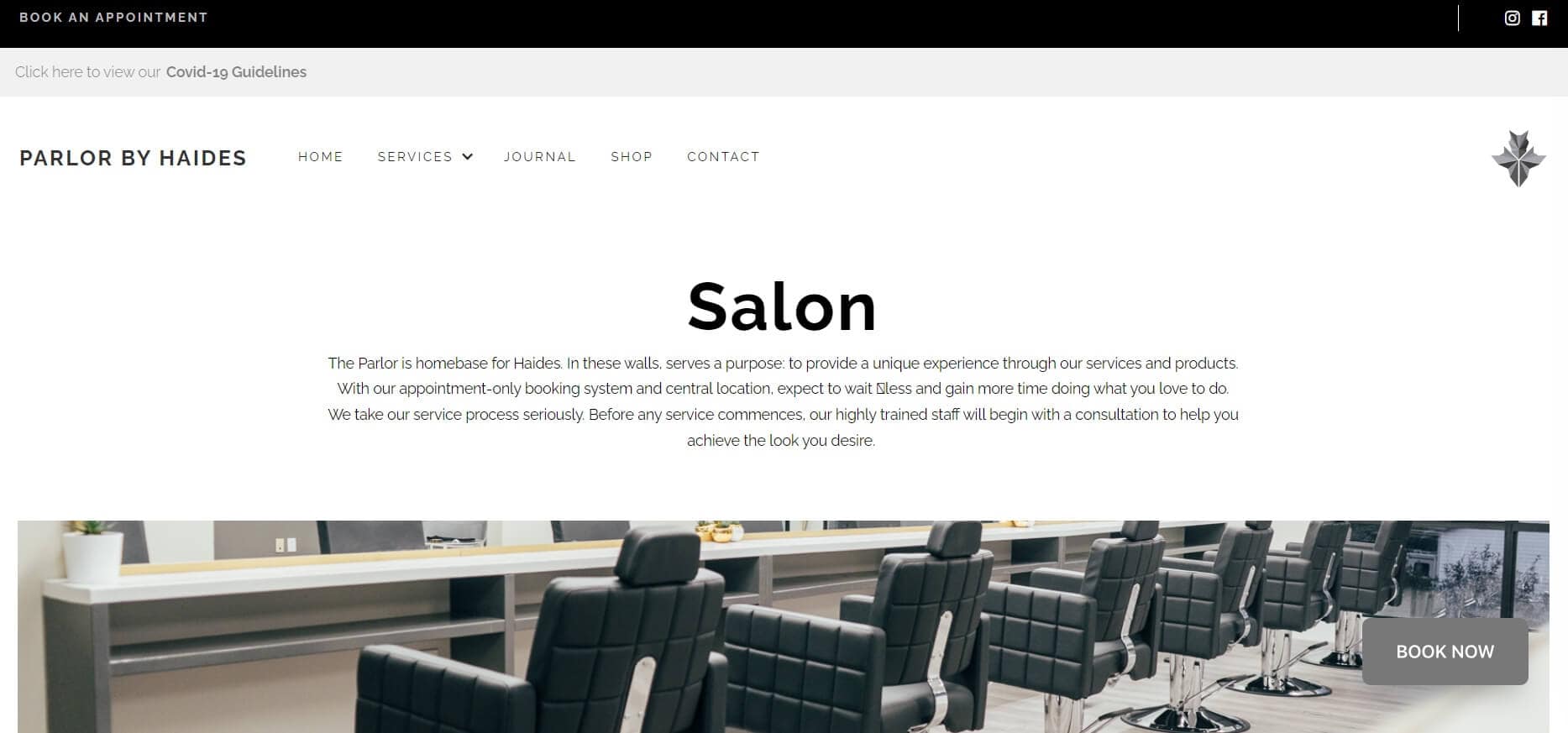
Along with a list of their services:

And great photos of their work along with pricing and how-to book.
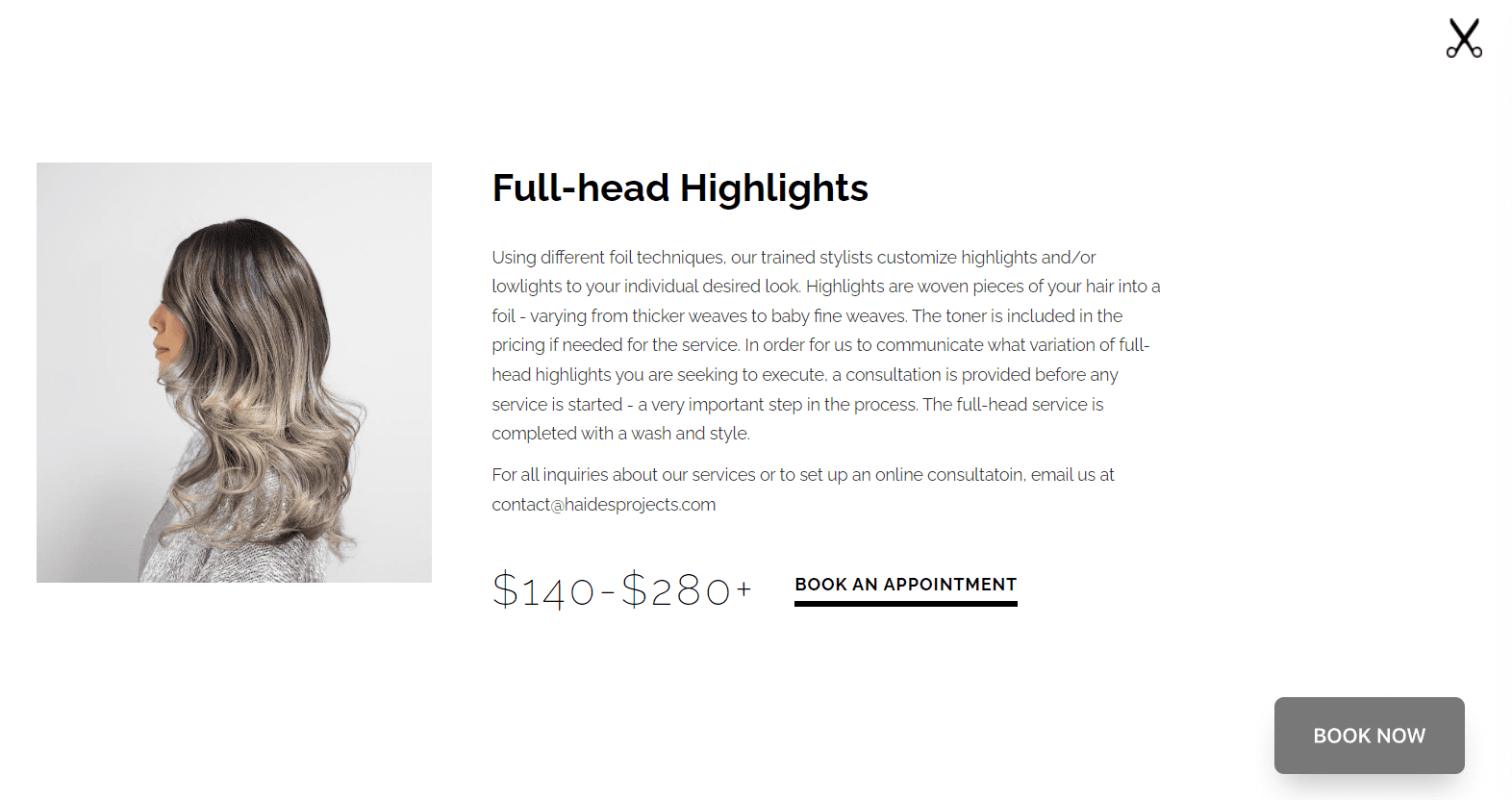
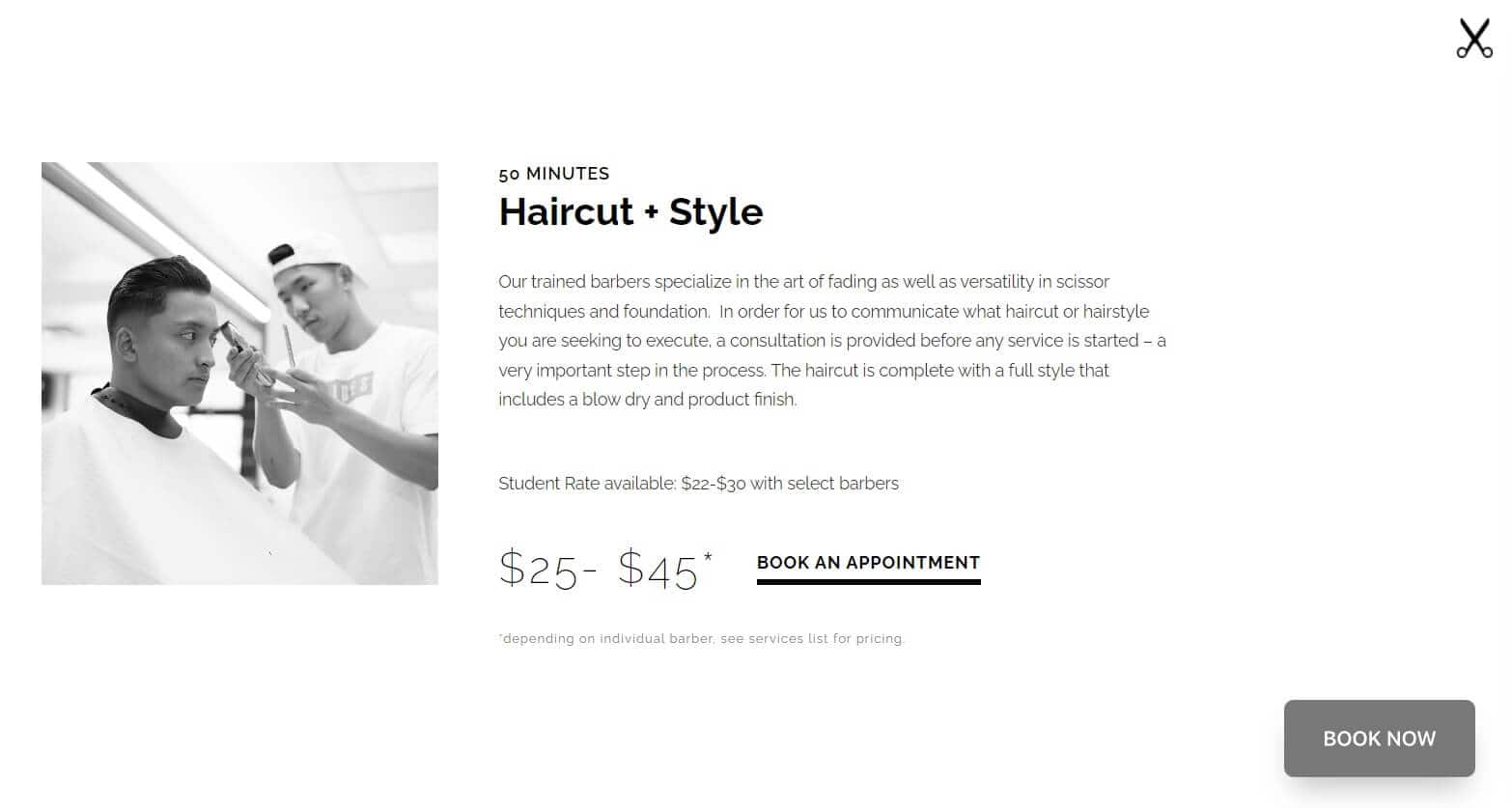
Page 3 and 4 - Journal and shop
Here, they provide local interest stories, a powerful way to connect with their community.

And promote their range of products.
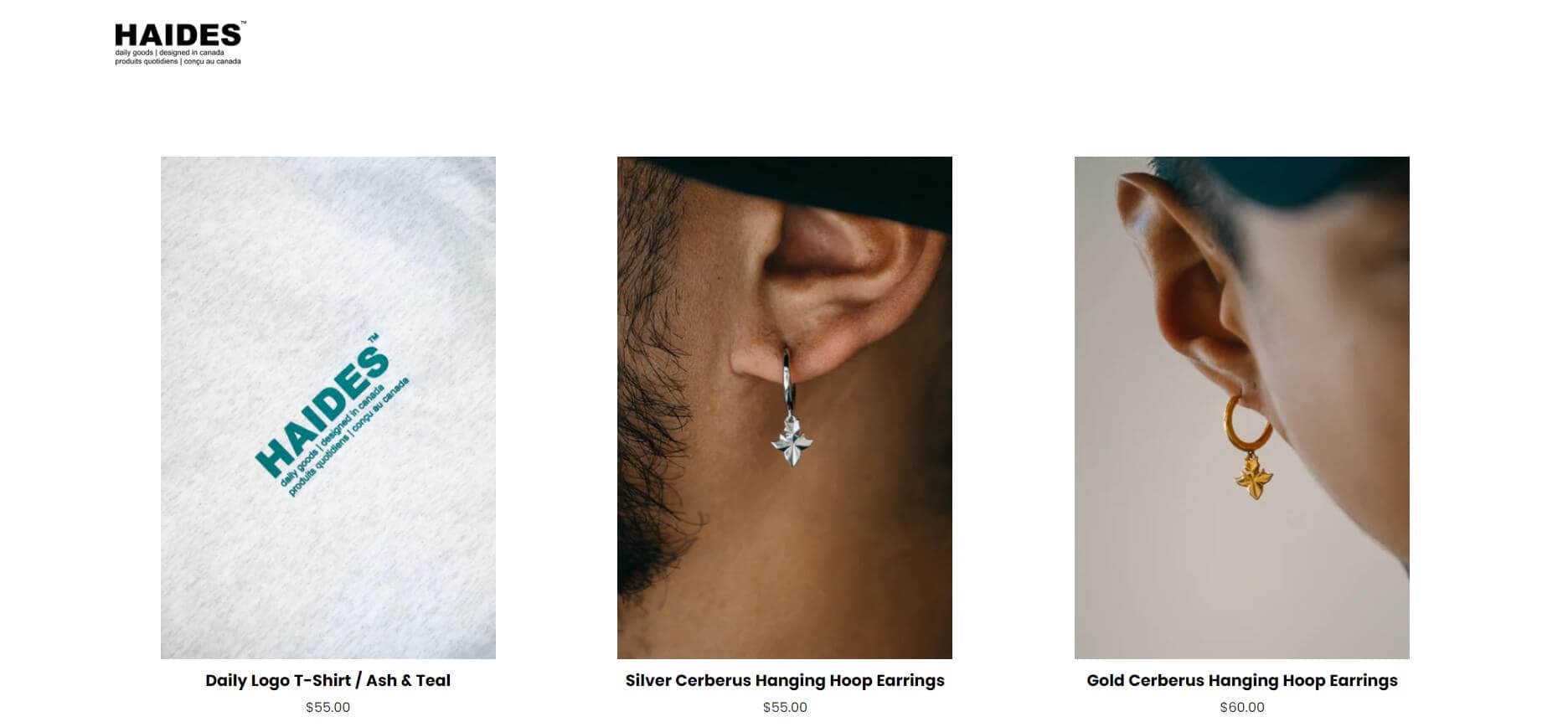
Page 5 - Contact
A simple layout that’s easy to use. Parlor by Haides asks for users’ emails so they can continue building client relationships.

And they finish with a location map.
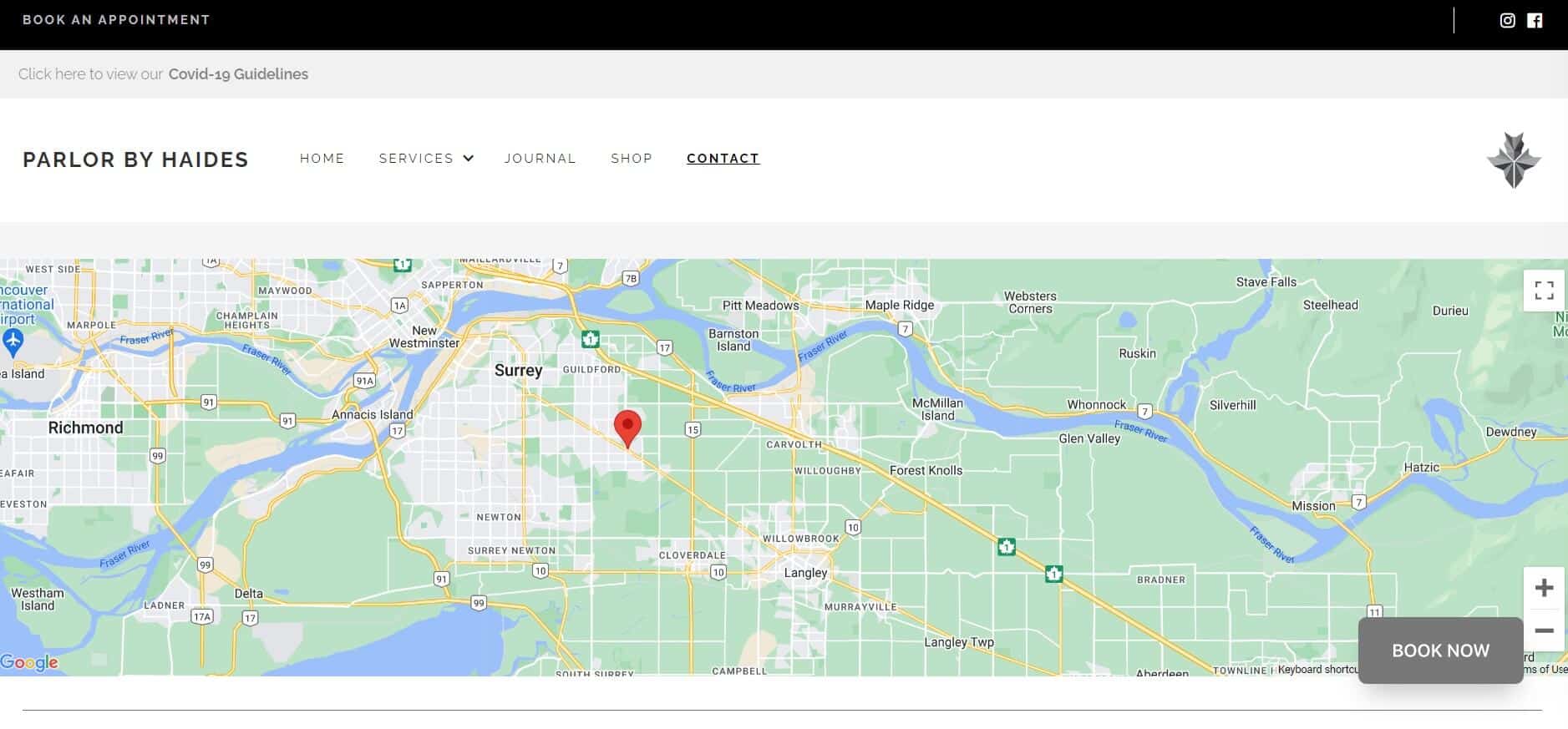
The takeaway is how simplicity and functionality create an engaging website that is easy for clients to navigate, find what they want and book an appointment.
And that, my friend, is that!
Congratulations, I’m proud of you because if you’ve got this far, you’re serious about opening a hair salon.
I know it’s a lot of information, so start slow and take it in stages.
And, like coloring a client’s hair, you should revisit this post several times! That`s cool; I`m not going anywhere.
And remember, even during uncertain times, your hair salon can prosper because, as the saying goes:
“Therapy is expensive; get a haircut instead.”
Good luck.
This portion of our website is for informational or educational purposes only. Tailor Brands is not a law firm, and the information on this website does not constitute legal advice. All statements, opinions, recommendations, and conclusions are solely the expression of the author and provided on an as-is basis. Accordingly, Tailor Brands is not responsible for the information and/or its accuracy or completeness. It also does not indicate any affiliation between Tailor Brands and any other brands, services or logos on this page.
Products
Resources
©2025 Copyright Tailor Brands